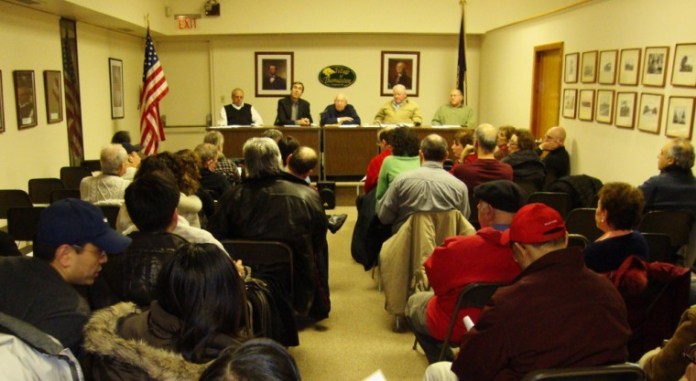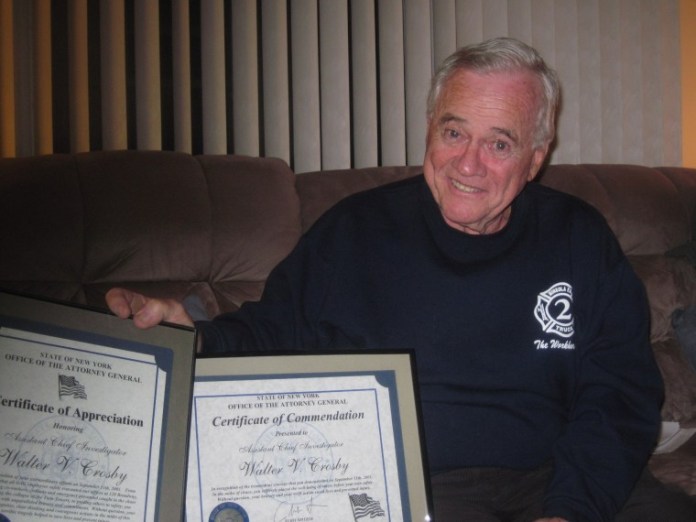Village of Thomaston Mayor Robert Stern called a special meeting last Wednesday to marshal local opposition against a pocket track extension proposed by the Long Island Railroad, calling on residents to contact local officials to express their concerns.
Stern said meeting was intended to update residents on recent activity involving the LIRR plan and to discuss ideas regarding the village’s next course of action. He was joined by dozens of residents who weathered snowy conditions to make their way to village hall to voice their opposition to the project.
Stern said in recent weeks he has given tours of the area to state Sen. Jack Martins (R-Mineola) and U.S. Rep Gary Ackerman (D-Great Neck).
“These are the men and women who vote on the money” said Stern. But Stern said he is frustrated with the lack of response he has been getting by the LIRR. Stern said the LIRR stopped communicating with him after learning of his opposition to their plan.
The pocket track extension is part of a $36 million project that would also replace the 113-year-old Colonial Road Bridge in Thomaston and improvement drainage. The LIRR has said the project is an essential part of its plans to improve service on the heavily used Port Washington line, which includes bringing the LIRR to Grand Central Terminal in 2016.
Stern said there is funding in the LIRR’s budget for the track extension, but appropriations needed to replacement the Colonial Road Bridge are not.
Stern said the “100 percent unsafe” bridge might be fixed as part of the five-year plan if funds are available in future budgets.
“Does anyone remember the bridge is dangerous?” said Stern.
With oversight of the Mass Transit Authority, the mayor suggested that elected officials might have the power to stop railroad construction by controlling funding.
“If we don’t make an effort now, the railroad will go ahead with their plans and we will have a noisy track to live with from now on,” Stern said.
Stern met with LIRR officials Dec. 13 at the Long Island office of U.S. Sen. Kristin Gillibrand to discuss the track-extension project, which the mayor says is a “bad idea” for Thomaston.
Because the LIRR is owned by the people of the state of New York and not staffed by elected officials, Stern said the railroad is insulated regarding concerns against the proposed pocket-track extension.
“So we just have to call them and we have to be pretty vigorous about it or they just won’t listen,” said Stern. “Up to now, my hollering is working its way back up and its coming to the attention of local officials.”
The LIRR’s multi-million dollar plan calls for the replacement of the bridge, drainage improvements and an extension to the existing pocket track that allows trains to turnaround by 1,200 feet to accommodate a 12-car train.
Stern has insisted that bridge repairs and drainage problems can be solved without adding the extra track.
According to railroad representatives, the LIRR has been working closely with Thomaston for three years while looking at all options; although they have remained firm in their efforts to address the project as one whole issue.
Stern said the money for the track extension has been secured, but funding for the much needed bridge replacement remains unfunded.
“If funding is available in the five-year plan, the bridge will be taken care,” Stern said.
Thomaston has pushed hard for repairs to the Colonial Bridge since 2007, warning the LIRR and other elected officials, including U.S. Sen. Charles Schumer (D-New York), and state Sen. Craig Johnson (D-Port Washington), that a “dangerous condition exists” regarding the bridge which does not comply with state Department of Transportation sight standards and creates flooding during heavy rainstorms that causes delays on the Port Washington line.
Stern criticized some in the media for recent articles regarding the LIRR situation in Thomaston.
“This is the kind of thing that has been going around and confusing people,” said Stern, referring to a recent published article by columnist Karen Rubin which was distributed at Wednesday’s meeting.
Stern opened up the discussion to anyone wanting to speak, except the media, who were given a chance to ask questions after the meeting ended.
One resident suggested that Stern recuse himself from talks involving movement of the bridge to another location because Stern lives near the bridge.
“I have the feeling that you are not necessarily on the same side as those that are going to be damaged by the move,” said one resident, who questioned the mayor’s stake in the bridge plan. While complimentary of Stern’s efforts as mayor, he recommended separating the bridge project from the pocket track plan.
“You will be damaged by the pocket track, but you might actually be quite pleased to have the bridge moved,” he said.
Saving his comments on the accusation until the end of the meeting, Stern said the board is only interested in doing the right things for citizens.
“I have every single garbage pale in this village on my mind,” said Stern. “Whether it’s mine or not doesn’t mean anything.”
Another resident suggested the bridge should be closed as soon as possible for safety reasons.
“From the safety point of view, it’s clearly it’s the safest thing to do before a tragedy,” said local resident Mike Zurin.
Others were worried about issues such as noise levels and environmental affects. Others said they have been left out of the discussion.
“I don’t know why the railroad has been insistent that we do not count at all,” said Willa Morris, who lives close to the track.
Other suggestions from those in attendance included starting legal action against the LIRR; form a subcommittee to explore options; and turn the bridge into a walking bridge.
The LIRR has said it welcomes comments from residents with recent dialogue has centered around a noise reduction wall which was proposed by Stern at a Dec. 13 meeting with the LIRR at the Long Island office of U.S. Sen. Kristin Gillibrand.
At last week’s meeting, Stern said the meeting was “inconclusive.”
Long Island Rail Road President Helena Williams has stated that Thomaston is a key juncture on the Port Washington line because line goes from two tracks to one in Great Neck and there is no other turnaround until a train reaches Port Washington.
E-mail Rich: rjacques@archive.theisland360.com













